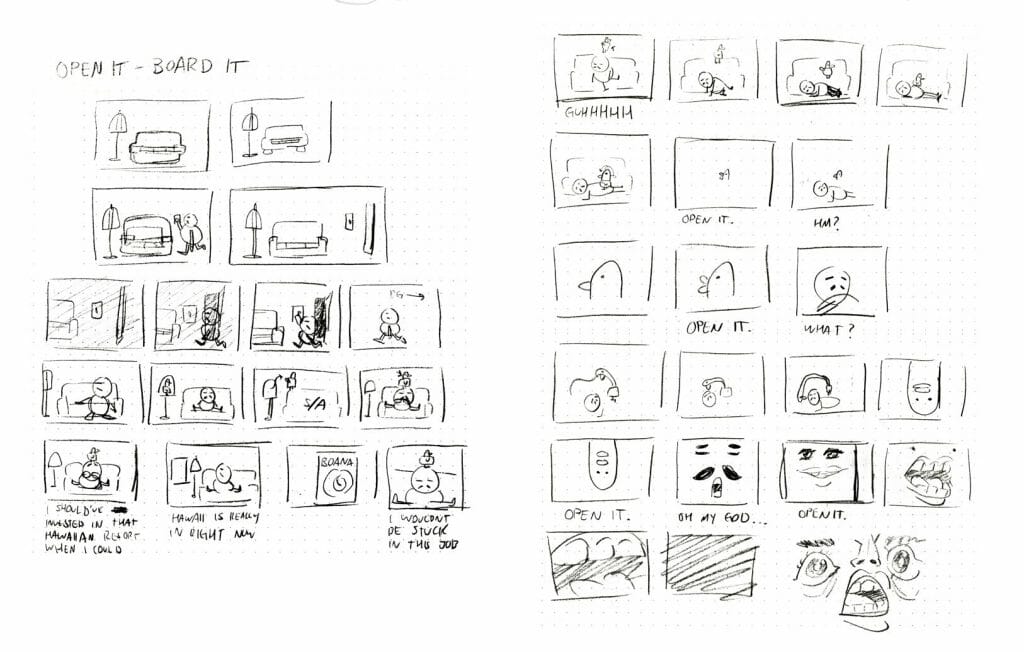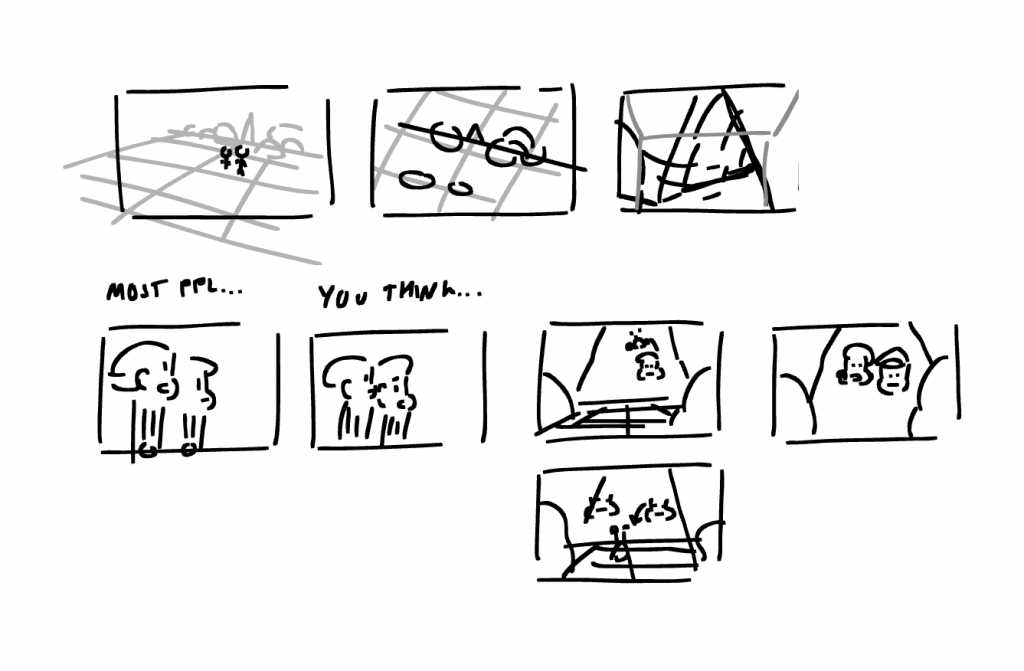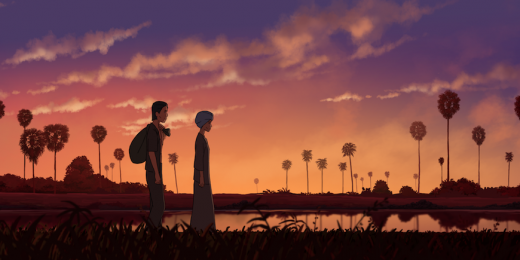
Leo Garcia is a storyboard artist who got his start in the industry as a production intern at Cartoon Network in 2016. From there, he moved on to become junior compositing artist at Duncan Studio in 2018, before moving into storyboarding. Today, he is a board revisionist at Nickelodeon.
We caught up with Leo to learn more about his journey into storyboarding. We discuss his storyboarding career so far, his experience working remotely from Mexico, as well as two of his personal projects, Frog King and Package Deal.
How did you become interested in animation, and how did you turn that interest into your career?
Leo: I was a classic kid, I loved drawing. I sat in class drawing comics with my friends. My childhood home was very animation centric, we had a long shelf that was totally filled with VHS tapes of classic Disney films, like Snow White and Cinderella. My family knew those tapes back to front. And we also watched lots of television series on Nickelodeon.
But by the time high school rolled around, I lost interest in it. A couple years later, when I got to college, I realized I was curious about animation. But because I hadn’t been drawing since I was a kid, I didn’t think I would be good enough to get into an animation program. Instead of animation, I decided to major in film. In that program, we had a class where we had to do lots of coordination; I had to book actors, scout locations. I was stressed about doing that because I’m not super social, I don’t really like talking to people.
I realized that if I was an animation major, I could just draw all this. At that moment, I decided that animation was what I wanted to do. So I started putting all my effort into getting better at drawing and learning, and I eventually switched to an animation major. By the time I graduated, I had an internship at Cartoon Network. That internship gave me real world animation experience that truly cemented my passion for the industry.
What has your career looked like since finishing school?
Leo: I’m now a storyboard artist. I do freelance boards, but I also have taken full time gigs with studios. The most recent project I’m working on is Kamp Koral at Nickelodeon. My position on the series is animatic revisionist. It’s a fun job because I get to add in some jokes here and there.
Recently, we did a huge episode that they needed some extra help for, so I got to join as a ‘plusser.’ We take the episode and slightly reshape it by adding jokes, punching some jokes up, and adding funny poses. That was super rewarding. Being on Kamp Koral has taught me a lot about slapstick, which is not something I’d indulged in before.
As an artist currently based out of Mexico, do you tend to work mostly with US studios or do you work locally as well?
Leo: Right after graduating college I went to Duncan Studio in Pasadena to work on the visual effects for Mary Poppins Returns. This job was thanks to a friend who I’d met online, who’d just gotten a job there. She recommended me, and I got the gig. Since then I’ve also worked on projects in Mexico. I was on Villainous, a series produced by A.I. Animation Studios for Cartoon Network and HBO Max. I storyboarded for this series, and then got scouted to go to this Netflix show called Wonderoos.
The beauty of the animation industry now is that there are lots of remote work opportunities, so I’ve been able to work for studios in the US as well as Mexico. This is a recent shift that happened because of pandemic restrictions in recent years. It forced the industry to find ways to make the work from home model work. I recall hearing, before the pandemic, that revision work can’t be done remotely because it requires so much collaboration and communication. But four years later we’re doing revisions remotely just fine.

Do you find that there are differences between working for US studios and studios in Mexico?
Leo: I do find there are differences. Here in Mexico the animation industry mostly focuses around outsource work. Lots of commercial work, lots of ads and specific spec work. While we do lots of animation work, we’ve never had a full on pipeline for a show made here.
This is what made Villainous so unique. It wasn’t just a Mexican show. It was a Cartoon Network show that broke out onto the global stage. This was a departure from the usual commercial work done here in Mexico. TV series production is relatively new here, and so there are some growing pains, but I’m excited to see how the industry develops here.
In terms of comparing the industry in Mexico to that industry in the US, I’d say the biggest difference is simply that the US animation industry has been around for so long. It’s very established across all animation formats, like feature films, series, and commercial work.
Can you share how you learned to use Storyboard Pro, and how it helped you throughout your career?
Leo: When I was in college there was a class on screen design. This class was the first time I ever boarded anything, and I had to use Photoshop to do it. I remember finding it frustrating to board using Photoshop because it just didn’t have the features you need. For example, it’s really hard to board something when you can’t go back and forth between your panels.
It wasn’t until another class in college that I got to learn how to use Storyboard Pro. It was a super fun class because we all had to make a short film in just ten weeks. Throughout the process we got little to no input beyond presenting our work for critique. The focus was truly on pushing each student to create their own vision.
During this ten week process I was learning Storyboard Pro as well as Harmony. It was a really fun time because I was learning not just how to use the software, but how to use it to my advantage. By the time I worked on my thesis film my approach to storyboarding had grown into this really familiar workflow that I still use to this day.

What do you love most about the craft of storyboarding?
Leo: I love that storyboarding feels like a big puzzle to me. When I first start, and there’s nothing on the page, I’ve usually envisioned several key moments in my head. I begin by putting down those moments. From there, I work backwards to fill out the missing pieces. It’s a puzzle to figure out how I’ll get to those key moments.
I also love how storyboarding can be used to visually communicate things that aren’t in the dialogue, or things that might be implicit. It’s really exciting to use visual language rather than hand feeding a story to the audience. As a storyboarder, I’m a big part of creating that visual language.
Beyond just using drawing to communicate, I also get to have some sneaky fun. I can sneak things into the background of a scene or create Easter eggs for the audience to find.
Could you share with us a bit about your storyboarding process. How do you approach storyboarding?
Leo: If I’m starting the storyboarding process from a script, I like to break it down into different difficulties. I decide which scenes will be harder to storyboard, which will be medium difficulty, and which will be easiest.
Next, I thumbnail as much as I can, approaching it by difficulty levels. This thumbnail stage doesn’t need to be precious. I usually just scribble thumbnails by hand onto legal paper. Since you can only fit so much into a thumbnail, I use this part of the process to figure out basic things, like what a silhouette will look like, what kind of elements I’ll bring into the shots, and what needs to be communicated with each shot. Because there’s so few stakes in the thumbnails, it’s the part of the process where you can try out different things. Thumbnailing is tedious, but very important. It’s the roadmap I look to when I actually start boarding.
Once I begin putting it into digital, I like to start with easy poses like talking heads. With these scenes I can usually go straight to cleanup. For more complicated scenes, I like to add a rough pass, so I go from a thumbnail to a rough pass, and then cleanup. Cleaning is a lot of fun because if you have a good model, you can experiment with figuring out how to transport that character into poses.
In short, my process is to go from thumbnailing to roughs to cleanup. I will say though that I jump around a bit. I mentioned that I mark scenes by difficulty. This is because I like to start by getting the difficult scenes done and out of the way. And in moments where I’m not up for a challenge, then I can easily shift gears to work on a more simple scene.

As a storyboard revisionist, what are the most helpful features of Storyboard Pro?
Leo: The light table feature in Storyboard Pro is a total lifesaver. Without that I would not be able to do the boards that I want to do. It’s really helpful to track where something is going in that same panel. Sometimes I will copy a post from an earlier scene in a new panel, and then use the light table to reference it, to keep sizes consistent.
The auto-matte is my other favourite feature. To be able to just press a button and have a whited out character saves me so much time.
You have published storyboards for two of your personal projects on your site, Frog King and Package Deal. What inspired these 2 stories?
Leo: Frog King was one of the first samples that I did shortly after college. I really wanted to create an excerpt where you don’t know exactly what the characters are doing, or where they are going. I just wanted to communicate their relationship.I hadn’t written much dialogue before, and so that was a big focus in creating Frog King. It was fun to take this little piece of a bigger story, and figure out how to communicate to the audience little bits of what was happening in the larger narrative. There was a challenge to this because I couldn’t possibly give audiences every detail. Instead, I tried to give enough information that the story could be followed, and was interesting.
The two main characters in the sample are kids who have seeds for heads. This might be funny, but part of the reason I chose to do seeds was because I wanted an excuse to draw a lot of plants! But I also found that the seeds were a great way to illustrate the idea of growing up. For example, the younger sister of the two kids has a sprout, signifying that she’s more mature than her older brother, who doesn’t have his sprout yet.
My other sample, Package Deal, was actually part of a test for a comedy show at Disney. I had been given the prompt to do an original story of my own. The only guidelines were that the story should involve two kids having an adventure in a city. At that point I had been to New York City once in my life, and I thought the subway was a lot of fun. From that, I knew that I would want these two kid characters to use the NYC subway to deliver something, all while one of them is having anxiety over their maturity levels. You might notice the tension of growing up is a theme in my work!
Creating Package Deal was an exciting chance for me to delve into writing comedy, and I also found that the set pieces for it were fun. One of my favourite things to draw in this sample was when the two kids are sitting in the subway and they have these lights pouring over them. I love indulging in little moments like that.

Do you have any advice for up and coming animation artists?
Leo: I think it’s really important to make things that excite you. It’s really easy to fall into this mindset where you’re trying to make the stuff that you know studios and recruiters want to see. But I find that when you make something that’s true to you, your excitement and passion comes through more. Don’t worry if your ideas are too cringe, too weird, or not good. Just make something for yourself.
For example, nobody told me that people wanted to see Frog King. It was one of those projects that I just wanted to write. So I figured, why not turn it into a sample. In the end, I found that people responded better to Frog King than to anything I’ve made that panders to expectations. Go out there and just make things that make you happy!

Do you have any upcoming projects you would like to share?
Leo: I’m in the middle of developing a graphic novel called Galaxy Vacation. It’s a romantic tragedy between two alien boys. The story is full of drama and focused around interpersonal relationships. It’s been super rewarding to write and draw, and so I’m super excited about this project.
Galaxy Vacation actually started as a pitch for a show, but I didn’t want to wait to do it. I realized that I could just go ahead and start working on the story in graphic novel form. I’m enjoying this format because it’s totally mine. I don’t have to present it to anyone, or do any pitching. Getting a show or film developed can involve a lot of other parties. But in making this on my own, I get to really focus on my own vision.
I finished the first draft of the outline recently, and I now have a lot of visual development feedback coming from people that I really trust. It’ll take some time before it’s finished, so stay tuned. I’d love to get it published, but first, I just want it out there, so I will publish it online.
- Interested in seeing more work from Leo Garcia? Be sure to visit Leo’s portfolio and follow him on instagram at @hiyaleo.
- Ready to begin your journey as a storyboard artist? Toon Boom Animation offers instructor-led training on Storyboard Pro Fundamentals.


